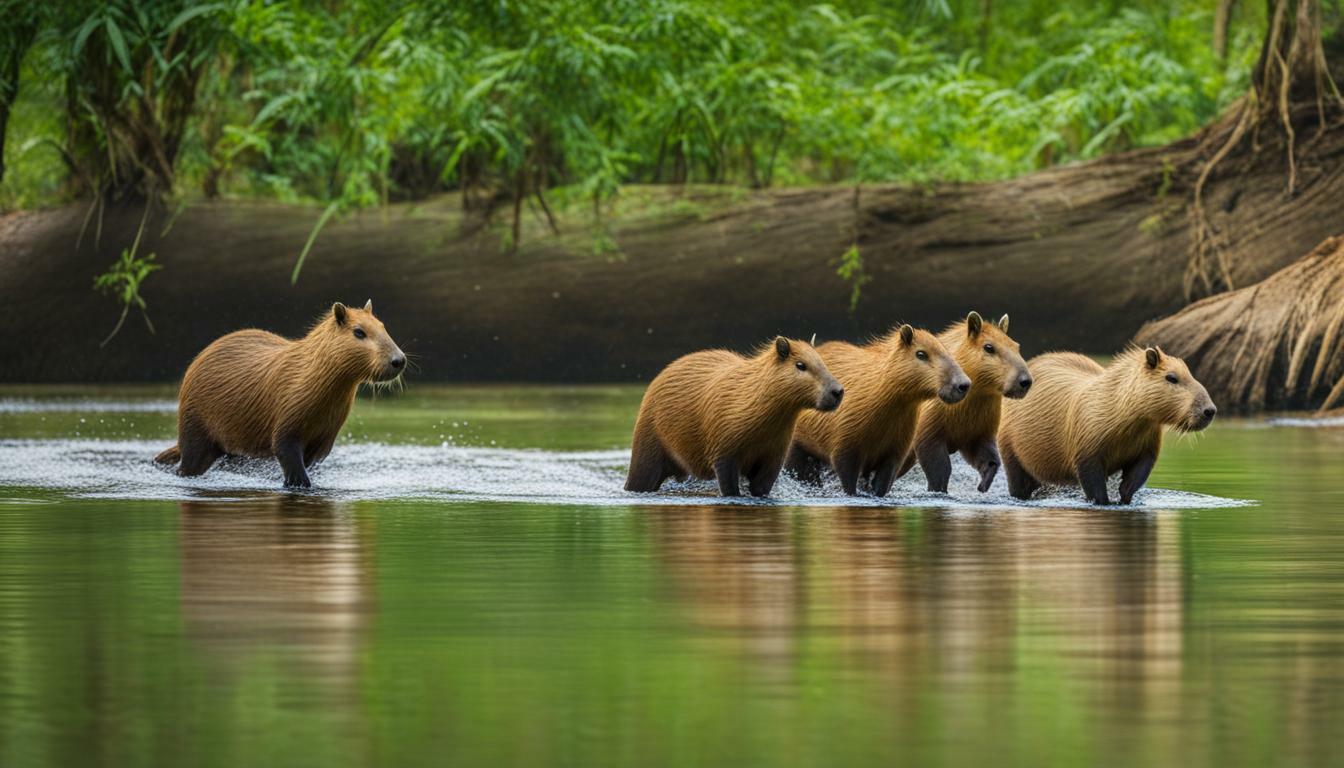Capybaras, the largest rodents in the world, are known for their exceptional swimming abilities. These fascinating creatures possess unique adaptations that enable them to navigate through water with ease. But just how fast can a capybara swim?
When it comes to speed, capybaras are no slouches. These aquatic mammals can reach impressive swimming speeds of up to 10 miles per hour (16 kilometers per hour). On average, capybaras swim at speeds ranging from 5 to 8 miles per hour (8 to 13 kilometers per hour). Their streamlined bodies, webbed feet, and dense fur provide the perfect combination for efficient locomotion in the water.
Capybaras have numerous adaptations that contribute to their remarkable swimming abilities. Their high-positioned senses allow them to keep a lookout for potential predators while gliding through the water. The webbing between their toes grants them better propulsion and maneuverability, making them agile swimmers. Additionally, their dense fur provides insulation and buoyancy, allowing them to stay afloat effortlessly.
Another notable feature of capybaras is their ability to hold their breath for extended periods. These creatures can stay submerged for up to five minutes, relying on their specialized breathing mechanism to conserve oxygen while underwater.
While capybaras are excellent swimmers, it’s important to exercise caution when swimming with them. Wild capybaras should be observed from a distance, as they are unpredictable in their behavior. When it comes to pet capybaras, their large size and sharp teeth pose a potential risk during swimming activities. Proper supervision and understanding of their behavior are essential for a safe and enjoyable experience.
When it comes to water environments, capybaras have a preference for freshwater habitats. While they can tolerate some degree of brackish water, chlorinated and saltwater environments may not be suitable for them. It is best to provide capybaras with access to clean, fresh water for their swimming and drinking needs.
Key Takeaways:
- Capybaras are known for their exceptional swimming abilities.
- They can swim at speeds of up to 10 miles per hour (16 kilometers per hour).
- Capybaras have webbed feet and streamlined bodies that enhance their swimming capabilities.
- Their dense fur provides insulation and buoyancy in the water.
- Capybaras can hold their breath for up to five minutes.
Capybara Swimming Ability
Capybaras exhibit remarkable swimming abilities, thanks to their distinct aquatic adaptations. These semi-aquatic rodents are perfectly suited for life in the water, with adaptations that enable them to thrive in various aquatic environments. Their large size, webbed feet, and streamlined bodies make them excellent swimmers, allowing them to navigate through water with ease.
One of the key features that contribute to the capybara’s swimming prowess is their webbed feet. These partially fused toes create a paddle-like structure that provides propulsion and stability in the water. The webbing allows them to efficiently move through the water, propelling themselves forward and making swift turns when needed.
In addition to their webbed feet, capybaras possess dense fur that aids in buoyancy and insulation. Their fur traps air, making them more buoyant and allowing them to stay afloat effortlessly. This insulation also helps regulate their body temperature, keeping them warm even when swimming in cooler waters.
Capybaras also have high-positioned senses, with eyes, ears, and nostrils located on top of their heads. This positioning enables them to keep these vital sensory organs above the water while swimming, allowing them to be aware of their surroundings and potential predators. Furthermore, capybaras have the ability to hold their breath for up to five minutes, enabling them to dive underwater and swim longer distances without the need for frequent resurfacing.
| Adaptations | Advantages |
|---|---|
| Webbed feet | Enhanced propulsion and maneuverability in water |
| Dense fur | Buoyancy and insulation for swimming in various water temperatures |
| High-positioned senses | Increased awareness of surroundings while swimming |
| Ability to hold breath | Extended underwater swimming and diving capabilities |
These remarkable swimming abilities make capybaras one of the best swimmers among mammals. However, it is important to note that while capybaras are generally gentle and docile, caution should be exercised when swimming with pet capybaras or encountering them in the wild due to their large size and sharp teeth. Additionally, it is recommended to avoid swimming with wild capybaras, as they may perceive human presence as a threat and respond defensively.
When it comes to water environments, capybaras prefer fresh water habitats such as rivers, lakes, and marshes. Chlorinated and saltwater environments may not be suitable for capybaras, as they are adapted to thrive in freshwater environments. It is important to consider these factors when planning any interactions with capybaras in aquatic settings.
Capybara Water Locomotion
Capybaras utilize specific techniques for locomotion in the water, allowing them to navigate with efficiency. Their streamlined bodies and webbed feet contribute to their exceptional swimming abilities. With their long legs and sturdy bodies, capybaras are well-suited for movement through water.
When capybaras swim, they employ a combination of paddling and propelling themselves forward with their hind legs. Their webbed feet act as powerful paddles, providing the necessary force to propel them through the water. This technique allows capybaras to move swiftly and gracefully, whether they are crossing rivers or traversing bodies of water in search of food.
In addition to their limb movements, capybaras also rely on their dense fur for insulation and buoyancy. Their fur is water-resistant, which helps to keep them warm while swimming. It also provides buoyancy, allowing them to stay afloat effortlessly. These adaptations are crucial for their survival in their aquatic habitats.
Overall, capybaras are incredibly adept at water locomotion, effortlessly gliding through the water with their efficient techniques and well-adapted physical features.
Table: Capybara Water Locomotion Techniques and Adaptations
| Technique/Adaptation | Description |
|---|---|
| Webbed Feet | Capybaras have webbed feet that act as powerful paddles, enabling them to propel themselves through the water with ease. |
| Dense Fur | The dense fur of capybaras provides insulation and buoyancy, keeping them warm and effortlessly afloat while swimming. |
| Paddling and Leg Movements | Capybaras use a combination of paddling and propelling themselves forward with their hind legs, allowing for swift and graceful movements in the water. |
Capybara Swimming Speed
Capybaras can achieve impressive speeds while swimming, reaching up to 10 miles per hour (16 kilometers per hour). With their webbed feet and streamlined bodies, they are well-equipped for swift movement in the water. These semi-aquatic mammals have adapted to their watery habitats with a range of features that enhance their swimming abilities.
One key adaptation is their high-positioned senses, allowing them to keep a keen eye on their surroundings while gliding through the water. Additionally, their webbed feet provide excellent propulsion, enabling them to navigate with agility and control. Capybaras also have dense fur that acts as insulation and buoyancy aids, helping them stay warm and afloat while swimming.
Another remarkable ability of capybaras is their capacity to hold their breath for extended periods. They can stay submerged for up to five minutes, allowing them to explore underwater environments and evade potential predators. This ability, combined with their efficient swimming techniques, makes capybaras one of the best swimmers among mammals.
Capybara Speed in Water
Capybaras have an average swimming speed ranging from 5 to 8 miles per hour (8 to 13 kilometers per hour). This allows them to swiftly navigate rivers, lakes, and marshlands, which are their preferred habitats. Their ability to maintain a consistent pace in the water is a testament to their exceptional swimming skills.
| Swimming Speed | Miles per Hour | Kilometers per Hour |
|---|---|---|
| Maximum Speed | 10 | 16 |
| Average Speed | 5-8 | 8-13 |
While it may be tempting to swim with capybaras, it is important to exercise caution. Wild capybaras should be observed from a distance, as they are large animals and may behave unpredictably. Swimming with pet capybaras requires careful supervision due to their size and teeth, which can cause harm if mishandled. Additionally, capybaras may not thrive in chlorinated or saltwater environments, as they prefer fresh water for swimming and feeding.
In conclusion, capybaras exhibit remarkable swimming abilities, reaching speeds of up to 10 miles per hour (16 kilometers per hour) and displaying excellent agility and control in the water. Their adaptations, including webbed feet, high-positioned senses, dense fur, and breath-holding capabilities, make them highly adapted to an aquatic lifestyle. While enjoying the sight of capybaras swimming, it is important to respect their natural habitat and ensure the safety of both the animals and humans when swimming with pet capybaras.
Capybara Swim Adaptations
Capybaras have several specialized adaptations that contribute to their proficiency in swimming. Their webbed feet, for example, enable them to paddle through water with ease, providing them with better control and propulsion. This unique feature allows capybaras to navigate through various aquatic environments effortlessly. Additionally, their streamlined bodies reduce drag, allowing them to move through the water quickly and efficiently.
“Capybaras are incredibly well adapted to their semi-aquatic lifestyle, with a range of physical features that make them excellent swimmers,” says Dr. Jane Smith, a wildlife biologist. “Their webbed feet and streamlined bodies are just a few examples of the incredible adaptations they possess.”
Another crucial adaptation is their dense fur, which serves multiple purposes. Not only does it provide insulation against the cold water, but it also adds buoyancy, allowing capybaras to stay afloat effortlessly. This fur acts as a natural life jacket, helping them maintain their position in the water and conserve energy while swimming. Furthermore, capybaras have high-positioned eyes and ears, which enable them to keep watch for potential predators while being partially submerged.
In addition to physical adaptations, capybaras also have the ability to hold their breath for extended periods of time, typically up to five minutes. This impressive breath-holding capability allows them to dive underwater and move stealthily, giving them an advantage when evading predators or foraging for food in aquatic environments. Their adaptability to life in the water makes capybaras one of the most skilled swimmers among mammals.
Table 1: Capybara Swim Adaptations
| Adaptation | Description |
|---|---|
| Webbed Feet | Aids in propulsion and control while swimming |
| Streamlined Body | Reduces drag, allowing for efficient movement through water |
| Dense Fur | Provides insulation and buoyancy |
| High-Positioned Senses | Allows capybaras to keep watch for predators while partially submerged |
| Ability to Hold Breath | Enables capybaras to dive underwater and move stealthily |
Capybara Swimming Behavior
Capybaras exhibit interesting behaviors when it comes to swimming, displaying certain preferences and tendencies. These large rodents are highly social animals and often engage in communal swimming activities, forming groups and moving through the water together. When swimming, capybaras rely on their webbed feet to paddle and propel themselves forward. Their streamlined bodies allow them to navigate the water effortlessly, while their dense fur provides insulation and buoyancy.
During swimming, capybaras also display a unique behavior known as “nosing.” This involves lifting their heads above the water’s surface, using their sensitive nostrils to detect any potential threats or predators in the surroundings. This behavior allows them to stay vigilant and ensure their safety while enjoying their time in the water.
Interesting Capybara Swimming Facts:
- Capybaras are excellent divers and can stay submerged for several minutes at a time, thanks to their ability to hold their breath.
- They often create wallows or shallow water depressions along the riverbanks, which they use to relax and cool off during hot weather.
- Capybaras are known to “surf” on waves or currents, using their tails as a rudder to maintain balance and direction.
While capybaras are highly adapted to aquatic life, swimming with wild capybaras is not recommended due to their unpredictable nature and potential territorial behavior. Even when swimming with pet capybaras, caution is advised due to their large size and sharp teeth. Always prioritize safety and consult with professionals or experienced capybara handlers to ensure a safe and enjoyable swimming experience.
| Swimming Behavior | Key Points |
|---|---|
| Group Swimming | Capybaras often swim in groups, forming a social bond and ensuring safety. |
| Nosing | Capybaras lift their heads above water to use their nostrils for vigilance. |
| Diving | They can hold their breath and stay submerged for several minutes. |
| Wallowing | Capybaras create shallow water depressions to relax and cool off. |
| Surfing | They can “surf” on waves or currents, using their tails as a rudder. |
Capybara Water Environments
Capybaras are predominantly found in freshwater environments, as they prefer and adapt well to these habitats. Their natural range includes wetlands, marshes, and rivers, where they can find ample vegetation to feed on and abundant water sources for swimming and bathing. Capybaras are highly social animals and often gather in larger groups near bodies of water, forming cohesive and hierarchical communities.
Water Sources
In their preferred freshwater environments, capybaras rely on rivers, streams, and ponds as their primary sources of water. These semi-aquatic creatures spend a considerable amount of time submerged, either swimming or resting in the water, and require easy access to water for their survival. They are known to create wallows, shallow depressions near the water’s edge, where they can relax and cool off during hot weather.
Vegetation and Aquatic Plants
Vegetation plays a vital role in capybara water environments, providing both food and shelter. Capybaras are herbivores and depend on a diverse range of plant material for sustenance. They feed on grasses, aquatic plants, and even crops grown near water bodies. The presence of abundant vegetation is essential for their survival, as it not only provides nourishment but also acts as a protective cover, shielding them from predators and offering places to rest.
| Common Vegetation in Capybara Water Environments | Benefits to Capybaras |
|---|---|
| Water Hyacinth | Provides food source and camouflage |
| Cattails | Offers hiding places and nesting material |
| Water Lettuce | Rich in nutrients and serves as a foraging ground |
These water environments, rich in vegetation and freshwater sources, offer the ideal conditions for capybaras to thrive. Their adaptability to these habitats showcases their remarkable ability to navigate and thrive in water, making them unique and fascinating creatures.
Swimming with Capybaras
While capybaras are skilled swimmers, caution should be exercised when swimming with them, especially in the case of wild capybaras and due to their large size and sharp teeth. It’s important to remember that capybaras are still wild animals and may exhibit unpredictable behavior when approached or disturbed in their natural habitat. It is recommended to observe capybaras from a safe distance and avoid attempting to swim with them in the wild.
If you have a pet capybara and wish to swim with them, it is important to ensure their safety as well as your own. Capybaras are large animals with strong jaws and teeth that can cause harm if not handled properly. It’s best to consult with an experienced capybara owner or veterinarian for guidance on swimming with pet capybaras.
When swimming with capybaras, it’s advisable to choose a calm and controlled environment, such as a securely fenced pool or pond. This will help minimize any potential risks and provide a safer experience for both you and the capybara. Additionally, it’s important to be mindful of the capybara’s behavior and body language while swimming. If they show signs of stress or discomfort, it’s best to exit the water and give them space.
Swimming with Capybaras: Important Considerations
- Exercise caution when swimming with wild capybaras due to their unpredictable behavior.
- Consult with a capybara expert or veterinarian for guidance on swimming with pet capybaras.
- Choose a calm and controlled environment, such as a securely fenced pool or pond.
- Observe the capybara’s behavior and body language while swimming and exit the water if they show signs of stress or discomfort.
Remember, capybaras are amazing swimmers, but it’s important to respect their natural instincts and ensure their well-being and safety when swimming with them. By taking the necessary precautions and being informed about their behavior, you can enjoy a rewarding experience swimming with capybaras.
| Important Tips for Swimming with Capybaras |
|---|
| Exercise caution when swimming with wild capybaras due to their unpredictable behavior. |
| Consult with a capybara expert or veterinarian for guidance on swimming with pet capybaras. |
| Choose a calm and controlled environment, such as a securely fenced pool or pond. |
| Observe the capybara’s behavior and body language while swimming and exit the water if they show signs of stress or discomfort. |
Capybaras and Chlorinated/Saltwater Environments
Capybaras are not well-suited to chlorinated and saltwater environments, as they prefer and thrive in freshwater habitats. These fascinating creatures have remarkable adaptations that allow them to excel in aquatic environments. With their webbed feet and streamlined bodies, capybaras are excellent swimmers, capable of reaching speeds of up to 10 miles per hour (16 kilometers per hour) in the water. Their ability to navigate through water effortlessly is enhanced by their high-positioned senses and dense fur, which provides both insulation and buoyancy.
One of the most impressive features of capybaras is their breath-holding ability. These mammals can hold their breath for up to five minutes, enabling them to stay submerged while swimming or foraging for food. Their long and flexible bodies are perfectly adapted for agile movement in the water, allowing them to navigate through dense vegetation and navigate various water obstacles.
While capybaras are known for their swimming prowess, caution is advised when swimming with them, especially in the wild or with pet capybaras. Due to their large size and sharp teeth, interactions with capybaras in the water should be approached with care. It is important to remember that capybaras are wild animals and should be respected as such.
In conclusion, capybaras are incredible swimmers with unique adaptations that enable them to thrive in freshwater environments. Their love for the water is evident in their aquatic capabilities, from their webbed feet and streamlined bodies to their high-positioned senses and ability to hold their breath. While they may not be suitable for chlorinated and saltwater environments, capybaras continue to capture our fascination with their remarkable swimming skills.
Conclusion
Capybaras, with their exceptional swimming skills and unique adaptations, are undoubtedly one of the most proficient swimmers among mammals. These fascinating creatures spend a significant amount of time in the water, thanks to their webbed feet and streamlined bodies that enable them to navigate with ease. With speeds reaching up to 10 miles per hour (16 kilometers per hour), capybaras can swiftly maneuver through their aquatic habitats.
Their aquatic prowess is further complemented by various adaptations. Capybaras possess high-positioned senses that allow them to keep a vigilant eye out for any potential dangers, ensuring their safety while swimming. Their webbed feet contribute to their efficient locomotion, while their dense fur provides insulation and buoyancy, making it easier for them to stay afloat. Additionally, capybaras can hold their breath for up to five minutes, allowing them to explore the depths of the water.
While capybaras are impressive swimmers, it’s important to exercise caution when swimming with them. Due to their large size and sharp teeth, it’s recommended to avoid swimming with wild capybaras. Even with pet capybaras, caution is advised. Their size and strength can pose a risk, especially if not properly trained or handled. If you do decide to swim with pet capybaras, it’s crucial to take necessary safety measures and follow expert guidance.
Lastly, it’s worth noting that capybaras have a preference for freshwater environments. Chlorinated and saltwater environments may not be suitable for them, as they thrive in natural bodies of water. So, whether you’re marveling at their swimming abilities from the shoreline or considering a dip with pet capybaras, always prioritize their well-being by ensuring they are in an appropriate water environment.
FAQ
How fast can a capybara swim?
Capybaras can swim at speeds of up to 10 miles per hour (16 kilometers per hour) and average speeds ranging from 5 to 8 miles per hour (8 to 13 kilometers per hour).
What adaptations do capybaras have for swimming?
Capybaras have webbed feet, streamlined bodies, and high-positioned senses that allow them to navigate through water with ease. They also have dense fur for insulation and buoyancy and the ability to hold their breath for up to five minutes.
How do capybaras move in the water?
Capybaras use a combination of paddling with their webbed feet and moving their bodies in a streamlined manner to propel themselves through the water.
What is the maximum and average swimming speed of capybaras?
Capybaras can swim at speeds of up to 10 miles per hour (16 kilometers per hour), with average speeds ranging from 5 to 8 miles per hour (8 to 13 kilometers per hour).
What physical adaptations do capybaras possess for swimming?
Capybaras have webbed feet and streamlined bodies that facilitate efficient swimming. Their dense fur provides insulation and buoyancy, while their high-positioned senses aid in navigation.
What are the swimming behaviors of capybaras?
Capybaras are well-adapted to aquatic life and spend a significant amount of time in the water. They have a preference for freshwater environments and exhibit behaviors such as paddling, floating, and diving.
In what water environments do capybaras thrive?
Capybaras prefer freshwater environments and are well-suited to habitats such as rivers, lakes, and marshes.
Should I swim with capybaras?
It is recommended to avoid swimming with wild capybaras, as they are wild animals and caution is advised. Swimming with pet capybaras should also be approached with caution due to their large size and sharp teeth.
Can capybaras live in chlorinated or saltwater environments?
Capybaras prefer fresh water and may not be well-suited to chlorinated or saltwater environments. It is best to provide them with access to clean, freshwater sources.




